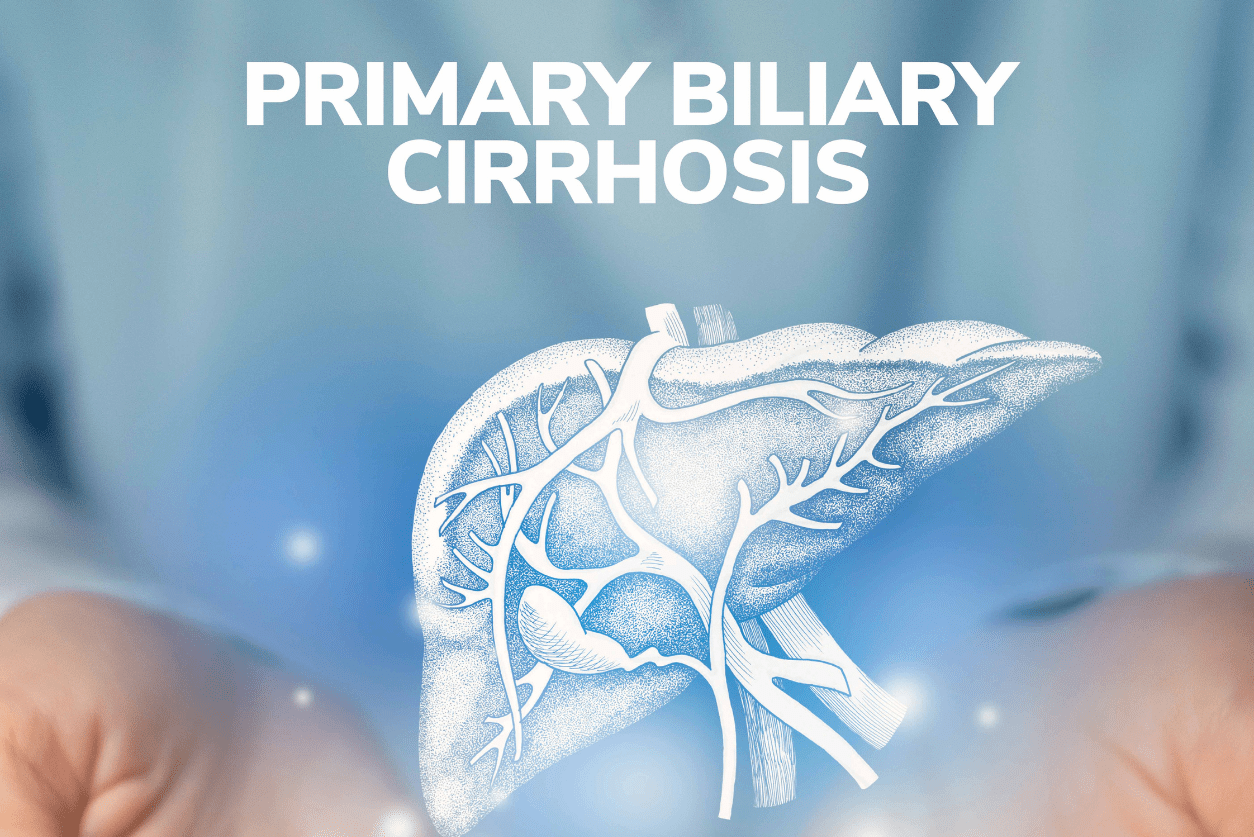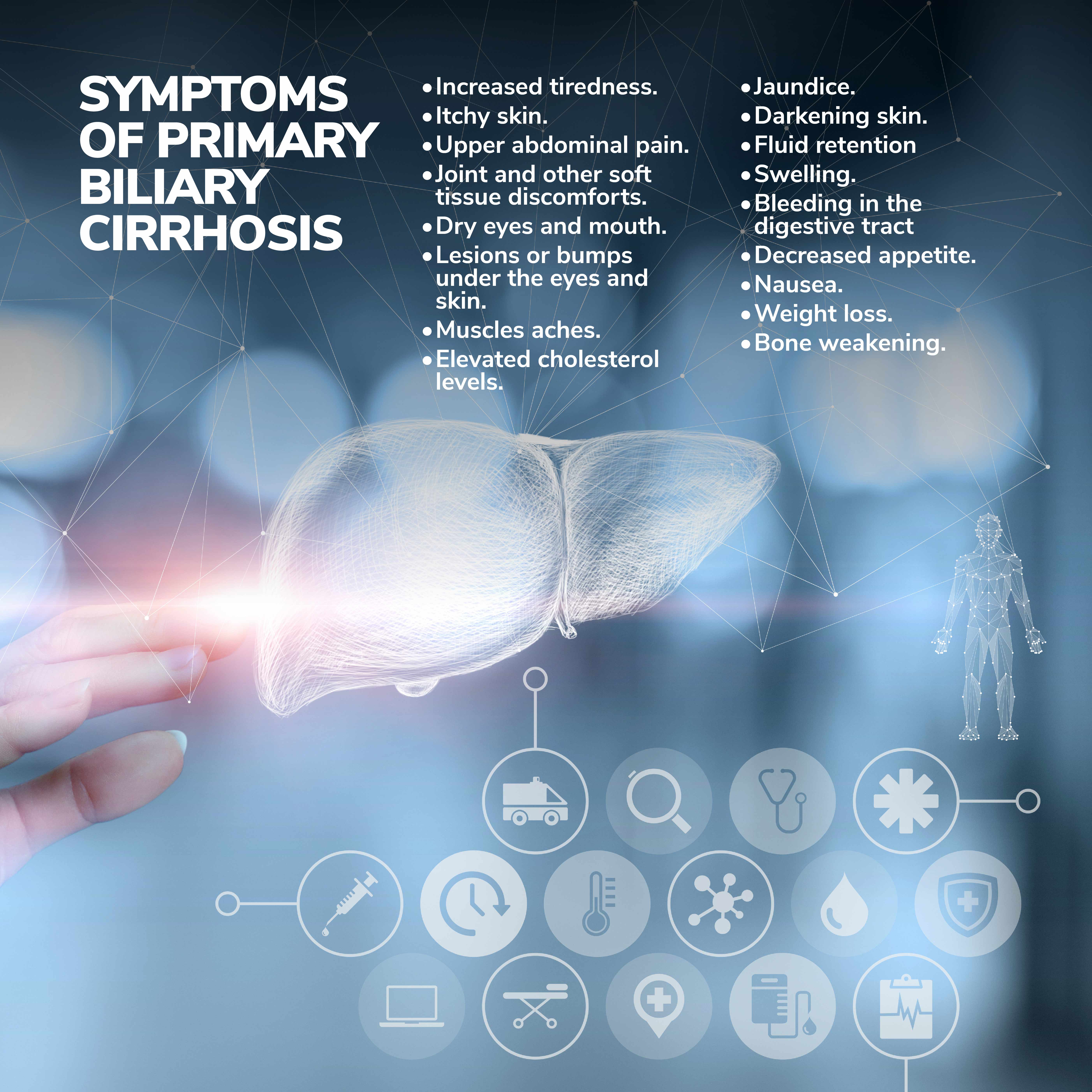
Primary Biliary Cirrhosis
Your liver is one of the body’s most important organs. This cone-shaped digestive system component located above your stomach is made up of sections known as lobes.
The liver performs many critical duties, including:
- Protein regulation.
- Blood clot formation.
- Blood filtration of chemicals and other waste products.
- Nutrient and mineral processing.
- Infection resistance.
Your liver produces and secretes a digestive juice called bile, which plays a crucial role in helping the body synthesize fats during the digestive process.
Over time, damage or disease weakens your liver and significantly interferes with its capacity to execute these life-sustaining functions. One particularly serious and potentially life-threatening liver ailment is classified as primary biliary cirrhosis.
Overview
Primary biliary cirrhosis, which is medically called primary biliary cholangitis, occurs when your liver’s bile ducts sustain damage and gradually deteriorate. The bile ducts store and release bile.
Causes
While researchers cannot pinpoint any specific causes, it’s suggested that the problem often results from bodily inflammation.
Often, this reaction stems from an underlying autoimmune illness causing the body’s immune system to attack its own cells. Many cases are seen in individuals with immune system disorders such as thyroid problems, celiac disease, scleroderma, and Sjogren’s Syndrome.
Risk Factors
Your risk of developing primary biliary cirrhosis increases depending on your:
- Age – The problem is most often seen in people between 30 and 60. Most cases occur between ages 45 and 60, but they can occur at any age.
- Gender – The illness typically occurs more often in women. Research has shown that 65 out of every 100,000 women have the disorder.
- Genetic Predisposition – Your risk increases significantly if a close family member has the disease.
- Cultural Ancestry – Primary biliary cirrhosis is more commonly seen in persons of northern European heritage. But cases have been reported in individuals of all races and ethnicities.
- Underlying Health Issues – Your chances are also greater if you are prone to certain types of infections. For example, primary biliary cirrhosis is far more common in those frequently diagnosed with urinary tract infections.
- Lifestyle Habits – Cigarette smoking and excessive alcohol consumption elevate your risk because they contain large amounts of abrasive and inflammatory materials. Exposure to airborne toxins or contaminated drinking water may also increase your chances.

Symptoms
Symptoms tend to vary depending on the individual, the illness’s stage, and if you have any other co-existing health concerns.
In certain instances, the early phases of primary biliary cirrhosis do not produce noticeable physical symptoms. Common initial symptoms include increased tiredness and itchy skin. As the problem intensifies, you may experience the following:
- Upper abdominal pain.
- Joint and other soft tissue discomforts.
- Dry eyes and mouth.
- The formation of lesions or bumps under the eyes and skin.
- Muscles aches.
- Elevated cholesterol levels.
As the disease reaches a more advanced stage, you might notice alarming and potentially serious symptoms, such as:
- Jaundice (the development of yellow skin and eyes).
- Darkening skin.
- Fluid retention.
- Bodily swelling.
- Bleeding in the digestive tract.
- Decreased appetite.
- Nausea.
- Weight loss.
- Bone weakening.

Complications
If not detected in an early stage, your chances of developing complications increase. Common issues include:
- Gallstones. They develop when bile cannot pass through your bile ducts smoothly and efficiently. These stones often cause pain, can obstruct the digestive tract, and cause infections.
- Portal Hypertension. A blood vessel called the portal vein transports blood out of your liver. Scar tissue resulting from cirrhosis might inhibit normal blood flow in the portal vein, increasing pressure inside the blood vessel and eventually damaging it.
- Vitamin Deficiencies. A disrupted bile flow interferes with your body’s ability to absorb essential nutrients like vitamins. As a result, systemic deficits of these substances occur, causing a wide array of symptoms.
- Diminished Cognitive Function. Diminished vitamin concentrations and the accumulation of toxins in your blood may lead to changes in mood and decreased cognitive functions like memory and focus.
- Liver Cancer. Scar tissue renders your liver’s cells more susceptible to structural abnormalities that can turn cancerous.
- Associated Health Issues. As mentioned before, primary biliary cirrhosis often results from co-existing autoimmune disorders. Afflicted subjects are also more likely to experience symptoms related to such ailments.
Diagnosis
Diagnosis requires the completion of a physical exam. During the initial phase, your doctor will gather information about your medical history and might ask questions surrounding:
- Your lifestyle habits.
- The over-the-counter and prescription medications you regularly take.
- If any family members have been diagnosed with primary biliary cirrhosis or any other form of liver disease.
- Your ancestry.
- If you live in a region with documented cases of air or water pollution.
- If you have been diagnosed with an underlying autoimmune or metabolic disease.
After obtaining this information, your doctor will record your vital statistics and look for any noticeable visual abnormalities suggesting primary biliary cirrhosis’s presence, such as jaundice, abdominal tenderness, and any unusual abdominal sounds.
Your doctor might also need to order diagnostic tests, such as:
- Liver biopsies.
- Liver enzyme measurements.
- Cholesterol readings.
- Anti-mitochondrial antibody readings.
- Internal imaging diagnostics like ultrasound and magnetic resonance imaging.
Possible Treatment Options
There is no known cure for primary biliary cirrhosis. Treatments are available that can ease symptoms and slow the disease’s progression.
The specific therapeutic protocol chosen by your doctor will depend on the disease’s severity, the symptoms you experience, and the presence of any complications. Several medications exist that can slow gradual liver scarring, improve liver function, and increase bile flow.
Symptoms are often addressed as they develop. For example, associated itching might be eased with antihistamines and antibiotics. Topical lotions and creams may also prove effective. Eye drops might lessen the occurrence of dry eyes. Chewing gum and hard candies might stimulate saliva production and ease dry mouth.
Other complications might be lessened or prevented through administering vitamin supplements, cholesterol-lowering medications, adhering to dietary restrictions, and diuretic drugs.
You might improve or lessen existing physical symptoms by consuming a balanced diet, remaining properly hydrated, not smoking, limiting alcohol intake, monitoring medications, limiting stress, obtaining adequate rest, and getting enough exercise.
In the most advanced cases, a liver transplant may be needed.
Prognosis
Primary biliary cirrhosis is chronic, meaning it lingers and eventually worsens with time. If detected relatively early, you can live a normal life for many years.
Prevention
Primary biliary cirrhosis cannot be prevented because the exact root cause is unknown. You may reduce your risk by:
- Drinking alcohol responsibly or not at all.
- Avoid smoking.
- Consume foods rich in vitamins such as A, D, E, and K.
- Stay physically fit.
- Drink enough water.
- Avoid foods containing potentially detrimental chemicals like salt, sugar, carbohydrates, and fat.
Above all, you should receive regular medical checkups. This is particularly important if you have a family history of primary biliary cirrhosis, another form of liver disease, or other considerable risk factors.
Contacting Us
Please contact us if you have been diagnosed with primary biliary cirrhosis or are experiencing the illness’s symptoms. Our practice began more than 15 years ago and has emerged as one of the leading gastroenterology practices in central Florida. We perform a host of diagnostic procedures using state-of-the-art equipment in a friendly, comfortable, and inviting atmosphere where patient care is always a top priority. Contact us today!